I could have titled this post “SEO Optimization 101” because this is an extremely basic tutorial on optimizing your Blogger blog content. Lucky for bloggers on Blogger/Blogspot, Google has made it super easy to manage your SEO settings within the Blogger dashboard. These five small SEO tips for Blogger will give you the most SEO bang for your buck.
If you are an advanced blogger you may already do some (if not most) of these things, and you are well aware that this is only the tip of SEO iceberg. I could write an entire series on optimizing your SEO on Blogger, but we are going to start with these baby steps since they are the low hanging fruit. In other words, if you don’t do anything else to optimize your SEO, at least you should be doing these 5 things.
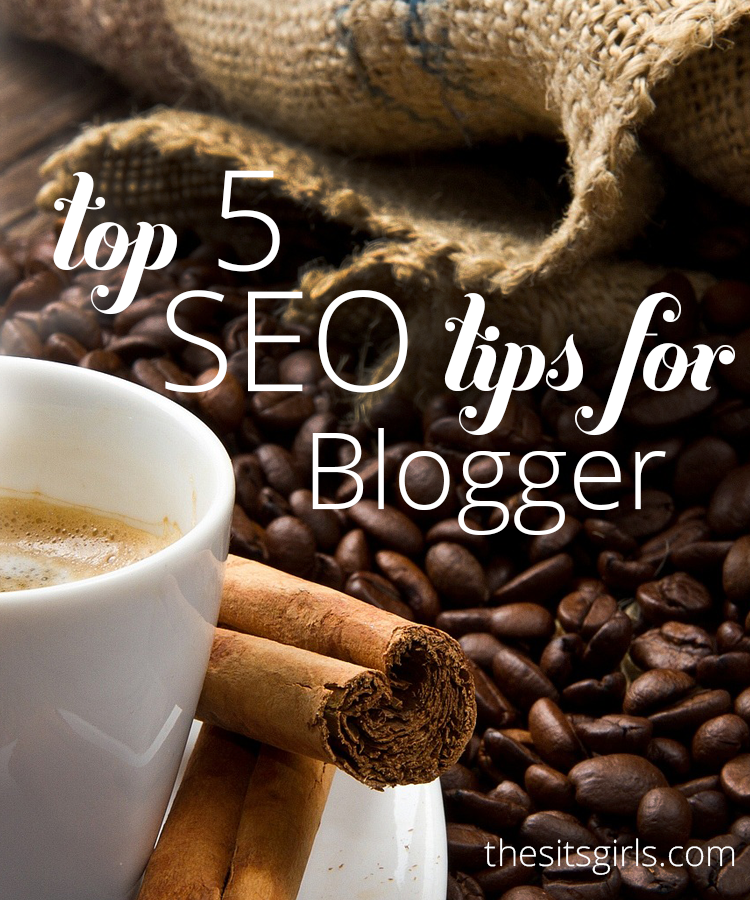
THE TOP 5 SEO TIPS FOR BLOGGER BLOGS
I want to assure everyone that none of these tips are difficult. They don’t involve any type of HTML or messing with your template. No matter how much experience you have using the Blogger platform, you can do this!
1. PRIVACY & DESCRIPTION
Did you know you have to allow search engines find your blog? I know this sounds SUPER obvious, but often it is overlooked. In many many blog reviews I have done, I have found that people don’t realize they actually need to give permission to search engines to crawl their site.
You can find the search engine permissions setting in your Blogger dashboard (Settings>>Basic>>Privacy). Make sure you have selected “Yes” to both questions:
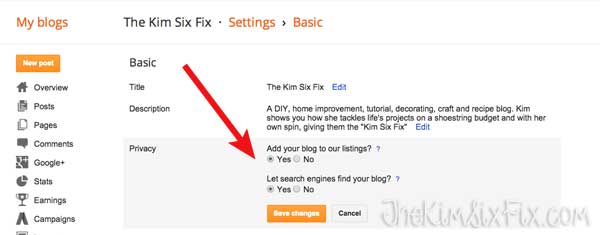
Add your blog’s description:
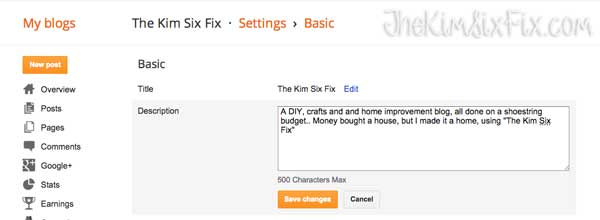
2. SEARCH DESCRIPTION
You find this setting in the Blogger dashboard under Settings>>Basic>>Search Preferences>>Meta Tags:
If you click the word “Edit” next to the description setting a box will appear for you to insert your blog description (you may already have a box there with a short description, but it may not be optimal). Keep in mind, whatever you write in this box is what is going to show up in search engine listings as the description of your url so make it good! You should have the main themes of your blog included in this description, so if you are a food blogger it should include the words ‘recipes’ or ‘food’ or ‘cooking’ while if you blog about fashion it should include ‘fashion’ as a keyword.
This isn’t the place to say “I love coffee and the color purple and my favorite animal is a unicorn” unless, of course, your blog is about sparkly coffee drinking purple unicorns.
For an example here is what my blog’s search description is:
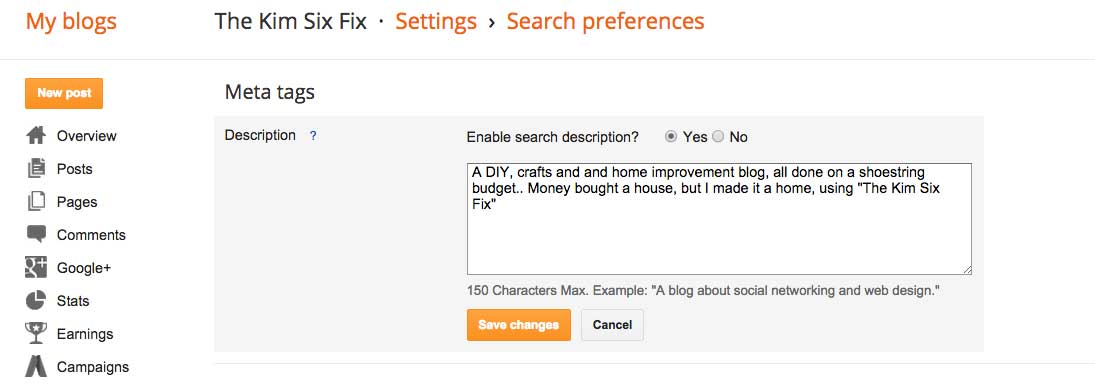
And here is what you get when you search for my blog on Google:
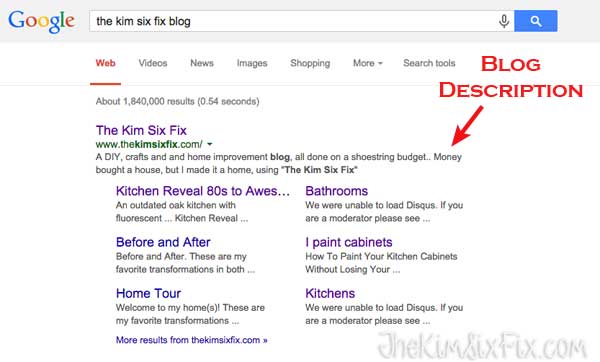
If you don’t have a blog description, Google will pull up the first line of text of one of your recent posts instead. That may mean you aren’t always putting your blog’s best foot forward.
As an example of why having an accurate description is important, I modified the searches to show you how the results change.
In this case I put “kim six fashion blog”. I NEVER blog about fashion so I don’t really want Google to pull up my blog for that term. And because of my description, it doesn’t:
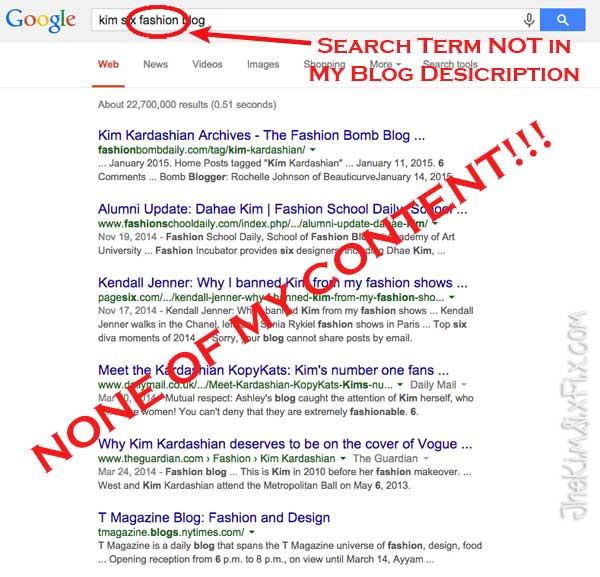
On the other hand, I do want it to pull up my blog when someone searches for the term DIY or home improvement. And low and behold, when I search for “kim six DIY blog” all the top listings are associated with my blog. THAT is the power of optimization.
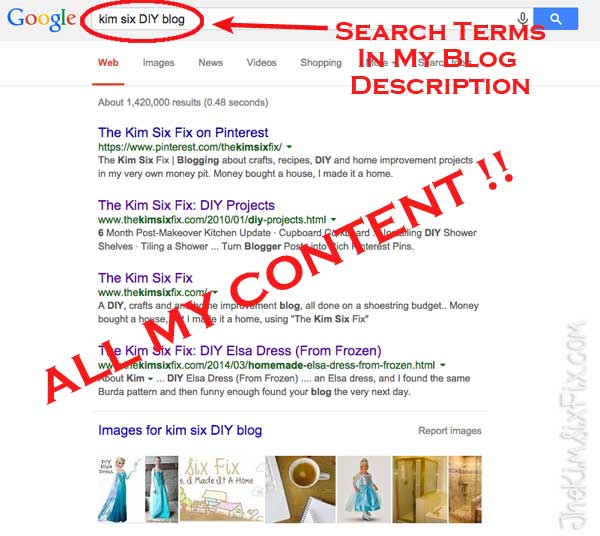
3. SEARCH DESCRIPTIONS
Once you edit your Blog Description in the settings panel, you will suddenly see a new option in the Blogger Posts Composition window called “Search Descriptions.”
This is exactly like your Blog Description, but it only applies to the specific URL associated with that post. Once again, you want to make sure you are including the keywords about the post content in sentence form. If you are writing a recipe for Fried Chicken your search description should include the words “Recipe” and “Fried Chicken” and perhaps the key ingredients. So something like “A fast and easy recipe for fried chicken using buttermilk and corn flakes.”
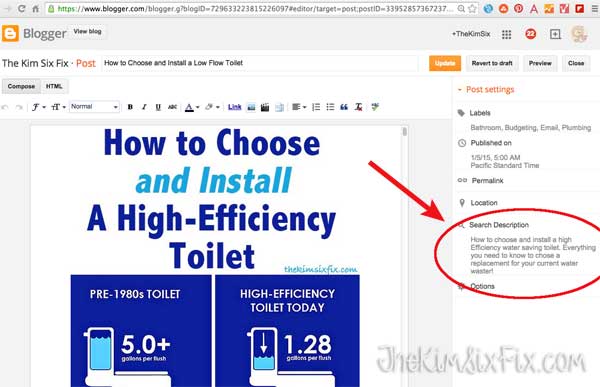
4. IMAGE NAMES (BEFORE UPLOADING)
This is my one and only tip on this list that isn’t specific to Blogger. This is true no matter what platform you are using.
Google actually looks at your photo titles when searching for keywords in a post, and they are the only thing google looks at when doing image searches. Yes, search engines also look at how you tag those photos.. but we’ll talk about that in #5. If you are uploading your photos and they are labeled “IMG_13849” google is just waiting for someone to search for that term. But I hate to break it to you, nobody is searching for “IMG_13849”
Your image titles should reflect the content they are about. If you are writing a post about painting a chair and have a photo of a chair that is half painted, you could label the photo something like “painting a chair” since that seems like a reasonable thing someone would search for, plus it actually describes what the post and photo are about.
But what do you do if you have LOTS of photos of the same thing? Well, what you don’t do is repeat search terms over and over. Make sure you mix it up. Many people know better than to leave their photos labeled with the IMG labels assigned by their camera, but they still aren’t completely optimizing their images for searchability.
Here is an example of only marginally optimized image labels in a post about Painting a Chair. I see photos labels like this all the time:
- Paint
- Chair Before
- Chair Before 2
- Painting a Chair
- Painting a Chair 2
- Chair After
- Chair After 2
- Chair After 3
Do you see a problem here? There are only 3-5 real ‘key words’ in those images: Chair, Paint/Painting, Before, After
Those same images would be much more likely to come up in a larger variety of searches if they were labeled:
- Can of paint
- Preparing wooden chair to sand it
- Sanding chair before painting
- Painting dining room chair with milk paint
- Best technique to paint furniture
- Painted chair Before and after
- Chair makeover Using Annie Sloan Chalk Paint
- ASCP chair painting tutorial
How many keywords have we used for our images now? We have the same ones as before: Chair, Paint/Painting, Before and After
But now we also have: Preparing, Painted, wooden, sand/sanding, dining room chair, milk paint, technique, Best, furniture, Annie Sloan Chalk Paint, makeover, coverage, ASCP, tutorial
And isn’t that what the post is really about? Those image titles make it clear that this a tutorial about Annie Sloan chalk paint and a chair makeover.
Keep in mind when you are diversifying your photos labels, you don’t want to be keyword stuffing, where you throw in any possible related search term you can think of in an unnatural way. The labels should still be organic and actually describe the images. Don’t use titles that are nothing but a list of keywords “Paint painted chair seat sofa wood wooden” Google will catch you!
5. IMAGE ALT AND TITLE TEXT
Now that you have done all that brainstorming to come up with great image names, you can use them again to really drive it home with Google.
After uploading an image via the post composition window, you can click on it and it will pull up a menu for sizing, centering, adding a caption etc. One of the options in that window is “Properties” and this is where all your SEO information should go.
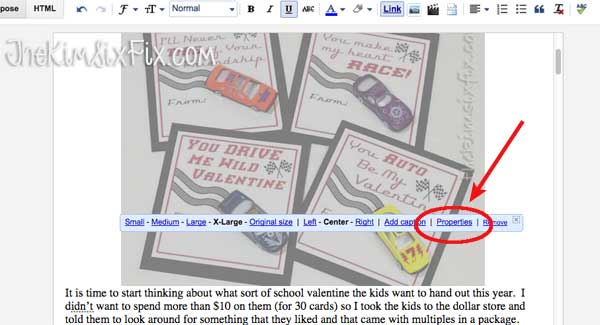
When you click on properties it opens a window with spaces to put you your title text and alt text.
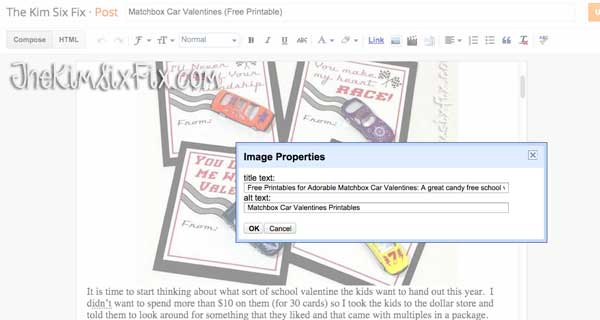
WHAT IS THE DIFFERENCE BETWEEN TITLE TEXT AND ALT TEXT?
The title text should be considered another way of labeling an image to reflect the content. It can be a little more descriptive and in sentence form. Another thing to keep in mind is that the title text is often the text that is pulled up by Pinterest when someone goes to pin your image.
Although this isn’t necessarily SEO, you want to include descriptions that would be good pin titles on Pinterest. And keep in mind, now that Pinterest is using keywords to sort pins, you want to make sure you are including them here as well. So in the painted chair example, you could use “This Annie Sloan Chalk Paint chair painting tutorial is one of the best I have seen and I would recommended it to anyone! Step by step photos and easy to follow instructions ”
On the other hand, the alt text is what is more important to search engines. Since google can’t “see” an image, they use the alt text to determine what your image is actually about. In some browsers the alt text are the words that pop up when you hoverover an image or if an image doesn’t load. The alt text should be sort and concise and include keywords in the same way I previously described naming your image files.
Again, you aren’t keyword stuffing the alt text, you want to keep it organic, but it shouldn’t be as descriptive as the title text. I, personally, would just re-use my photo file names in the alt text since those are already optimized.
I actually compose my blog posts in third party software which auto-populates both my alt and title text fields with my image names (score!) so I don’t have to manually go through and enter them one by one, but I do often go in modify my title text for my most Pin-friendly images.
And that is all there is to it. You have begun down the road to Search Engine Optimized content. Now those weren’t that hard were they? But the key is remembering them.
And to help with that I’ve included a free printable Blogger Post Checklist for anyone composing their content in Blogger, to help your remember and keep track of all the steps:
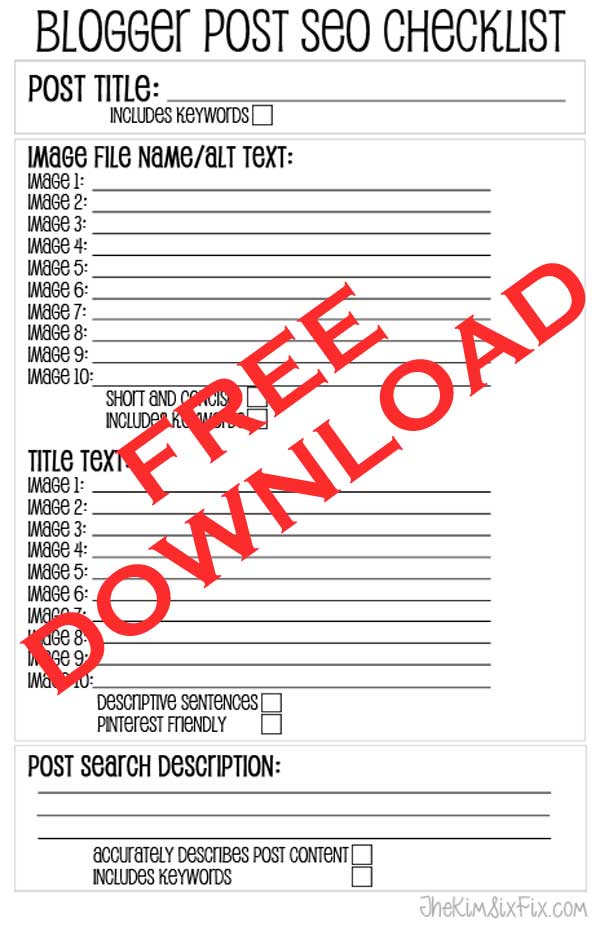
I hope this has been useful (or at least a good reminder) to anyone who is worried about their SEO on Blogger. I know it can be intimidating and confusing, but it doesn’t have to be…thanks to Google’s favorite blogging platform!
If you liked this article you may also like:
To view the original article Click Here

SEO is the best way to accomplish traffic to a website in search engines organic results page. You have explained it very well in here. Thanks for sharing this. You have provided really a great content in here.
ReplyDeleteSEO Training Center in Chennai | SEO Training in Chennai | Best seo training in chennai
Glad you liked it.. Thanks for the comment. :)
ReplyDeleteReally nice information you had posted. Its very informative and definitely it will be useful for many people
ReplyDeleteDigital Marketing Company in Chennai
Great tips for freshers and experience candidates for digital marketing. i would like to know about digital marketing jobs in hyderabad.
ReplyDeletethis is the right place to find for right information.thanks for sharing the useful post about blogger tips and appreciated.keep it up
ReplyDeleteGIS jobs in hyderabad
Great Article
ReplyDeleteFinal Year Project Domains for CSE
Project Centers in Chennai
JavaScript Training in Chennai
JavaScript Training in Chennai
Very Informative blog thanks for sharing Searching for a SEO company in Chennai that can bring your brand to the top results page on Google.
ReplyDeleteGreat article. I cover every point of my doubts. I loved this post.
ReplyDeleteThank you so much for this article.
Regard,
Digital Marketing Company
Great Article Artificial Intelligence Projects
ReplyDeleteProject Center in Chennai
JavaScript Training in Chennai
JavaScript Training in Chennai Project Centers in Chennai